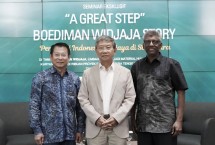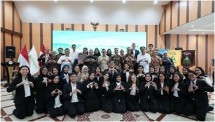How to cyber security: Invisible application security
By : By: Jonathan Knudsen, Senior Security Strategist, Synopsys Software Integrity Group | Wednesday, September 01 2021 - 01:35 IWST

Application security
INDUSTRY.co.id - I really love the keyless entry system on my car. The “key” is not a key in the traditional sense; all I have to do is put it in my pocket and forget about it. When I reach for the car door handle, it simply unlocks. When I leave the car, I wave my hand over the handle to lock the car.
This is nice because I don’t ever have to take the key out of my pocket, which lowers the risk that I will accidentally leave it somewhere or lock it inside the car.
But better yet, I don’t have to think about it. The car is locked until I need it to be unlocked.
Set-and-forget
This is a variation on set-and-forget, one of my favourite principles. If I’m going to spend time and money to fix a problem, I would like it to stay fixed.
For example, I have rain gutters at the edges of my roof to catch runoff. Unfortunately, these gutters also fill up with pine needles from nearby trees. I can solve this problem by clearing out the pine needles and other debris, but I’d have to do this at least once a year.
Instead, I can install a system that allows water into the gutters but not pine needles or leaves, which means I never worry about my rain gutters again.
Give your developers a clear runway
Software developers also want things that just work — they want problems to stay fixed. They like clear definitions and cleanly delineated responsibilities.
From this standpoint, the first generation of application security was a special kind of hell. Application security testing was performed very late in the software development life cycle (SDLC), typically just before release, when the development team thought they were done.
Security testing usually produces a very long list of findings, which might or might not be real problems, and which might or might not make sense to the development team. They thought they were finished, so they were frustrated by having a big pile of findings thrust upon them without necessarily understanding the implications.
In this first generation of application security, security teams were also frustrated. They worked hard to run security tools and were usually swamped with testing demands from all the development teams in an organisation.
Furthermore, many development teams, under time pressure to release products, might minimise or ignore the issues reported by security teams.
Invisible AppSec
In the second generation of application security, development teams could automate and integrate application security testing into the development process, creating a much smoother experience. Security teams, instead of scrambling to preform security testing for teams that don’t always appreciate their efforts, work as advisors and mentors to development teams.
In this second generation, developer workflows are minimally disrupted. When application security is automated into existing build and package processes, developers don’t have to think about it. And when application security results are integrated into existing issue-tracking systems, developers can work through security issues just like any other functional issues. Application security is a crucial part of the development process, but it fades into invisibility in a very positive way.
The coming Nirvana
A new generation of application security is happening now. If you have successfully transitioned to the second generation of AppSec, you have some new challenges to wrestle:
Different security tools produce different kinds of results in different formats. You need a way to combine, deduplicate, and homogenise results.
Application security is about managing risk. You need a way to triage and prioritise all your findings, so you can spend your time and money fixing the most dangerous findings first.
As you automate more security tools into your development process, you’ll realise that you probably don’t need to run every tool on every developer commit. You need an intelligent approach to orchestration so that you are running the right tests at the right time, making the most of your available resources.
Read Also
Wireless Logic Selected By Thales As IoT Connectivity Partner
Totolink Strengthens Commitment to Innovative and Reliable Network…
BDDC Inaugurates JST1 TIER IV Data Centre in Jakarta to Strengthen…
MoreLogin, the World's #1 Antidetect Browser, Showcased at Affiliate…
Experts gather in Nanning to support high-quality development of…
Today's Industry

Rabu, 21 Mei 2025 - 10:09 WIB
Indonesia, Thailand Sign MoU on Health Sector, Focusing on Global Capacity, Collaboration
As a part of President Prabowo Subianto’s official visit to Thailand, both countries signed a Memorandum of Understanding (MoU) on health sector, in an effort to strengthen bilateral cooperation…

Rabu, 21 Mei 2025 - 10:06 WIB
Indonesia, Thailand Deepen Cooperation on Security, Trade, and Regional Stability
resident Prabowo Subianto has reaffirmed Indonesia’s strong commitment to deepening bilateral relations with Thailand during the meeting with Thailand’s Prime Minister Paetongtarn Shinawatra…

Selasa, 20 Mei 2025 - 12:44 WIB
Boediman Widjaja's Technology Ready to be Adopted in Jababeka Industrial Estate (KIJA)
In an exclusive seminar entitled "A Great Step: Boediman Widjaja Story - Going from Indonesia, Thriving in Singapore" held at the President Lounge, Menara Batavia, Boediman Widjaja, Founder…

Jumat, 02 Mei 2025 - 10:46 WIB
Binawan and Government Support Indonesian Nurses in Europe through Scholarships
In the midst of the viral #KaburAjaDulu hashtag as a symbol of the young generation's disappointment with domestic working conditions, Binawan responded with real action: dispatching Indonesian…

Jumat, 28 Maret 2025 - 22:21 WIB
SUNeVision Initiates MEGA IDC Phase Two Development
SUNeVision, the technology arm of Sun Hung Kai Properties (SHKP), today announced the commencement of construction for Phase Two of MEGA IDC in Tseung Kwan O. As Hong Kong's largest data centre…
















News Comment